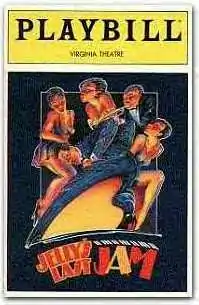| Jelly's Last Jam | |
|---|---|
 | |
| Music | Jelly Roll Morton Luther Henderson |
| Lyrics | Susan Birkenhead |
| Book | George C. Wolfe |
| Basis | The life of Jelly Roll Morton |
| Productions | 1992 Broadway |
| Awards | Drama Desk Award for Outstanding Book of a Musical Drama Desk Award for Outstanding Lyrics |
Jelly's Last Jam is a musical with a book by George C. Wolfe, lyrics by Susan Birkenhead, and music by Jelly Roll Morton and Luther Henderson. Based on the life and career of Ferdinand Joseph LaMothe, known as Jelly Roll Morton and generally regarded as one of the primary driving forces behind the introduction of jazz to the American public in the early 20th century, it also serves as a social commentary on the African-American experience during the era. LaMothe was born into a Louisiana Creole family that was established and free before the Civil War.
Plot
The play opens with the recently deceased Morton in a state of limbo, looking back on his life. He is reluctantly guided by the mysterious 'Chimney Man,' who forces him to recall the more painful moments of his life when he attempts to ignore or embellish them. Born into an old and wealthy mixed-race Creole family in New Orleans, the young Morton rebels against his upbringing by going into the streets and absorbing the rhythms of the vendors and poor blacks, meeting blues musician Buddy Bolden. When his Creole grandmother discovers his new lifestyle, she disowns him.
Forced to go on the road, Morton becomes a prominent composer and musician, and the self-proclaimed creator of jazz. His sadness over his family's rejection causes him to stress his Creole ancestry and claim that there are 'no black notes in my song.' Eventually his pride and racism cause him to betray his best friend and the woman he loves. In his later years, as the Jazz culture continues to grow, Morton is largely forgotten and reduced to dealing with crooked music publishers and gangsters, eventually dying of a knife wound in the colored wing of a Los Angeles hospital. At the moment of his death, Morton at last admits to his heritage - "Ain't no black notes in my song/I was wrong/ I was wrong." At this moment, the shadows of the people in his life surround him to congratulate him, and Morton takes his place in history among the other Jazz legends.
Productions
Jelly's Last Jam premiered at the Mark Taper Forum, Los Angeles, California, in March 1991. Directed by Wolfe, Obba Babatunde played Jelly Roll.[1]
The Broadway production opened at the Virginia Theatre on April 26, 1992 and closed on September 5, 1993 after 569 performances and 25 previews. The musical was directed by Wolfe, choreographed by Hope Clarke, with tap choreography by Gregory Hines and Ted L. Levy, scenic design by Robin Wagner, costume design by Toni-Leslie James, and lighting design by Jules Fisher.[2]
In addition to Gregory Hines and Savion Glover as the older and younger Morton, the cast included Keith David as the Chimney Man, Tonya Pinkins as Anita, Ann Duquesnay as Gran Mimi, Stanley Wayne Mathis as Jack the Bear, Mary Bond Davis as Miss Maime and Ruben Santiago-Hudson as Buddy Bolden. Stephanie Pope, Maime Duncan-Gibbs and Allison M. Williams appeared as the musical trio the Honies, with Ken Ard, and Brenda Braxton appearing in the show's ensemble. [2] later in the show's run, Phylicia Rashad, Brian Stokes Mitchell and Ben Vereen joined the cast, replacing Pinkins, Hines and David respectively.
An original cast recording was released by Decca Broadway.
The musical will be mounted by New York City Center Encores! from February 21, through March 3rd, 2024, in a production directed by Robert O'Hara with choreography by Edgar Godineaux and tap choreography by Dormeshia. Nicholas Christopher will appear as Jelly opposite Billy Porter as the Chimney Man, Joaquina Kalukango as Anita and Leslie Uggams as Gran Mimi. Pope, Duncan-Gibbs and Williams will reprise their roles as the Honies from the original broadway production. [3]
Song list[4]
|
|
Awards and nominations
Original Broadway production
Reception
John Lahr wrote the introduction to the printed script of Jelly's Last Jam, and noted that the musical "reclaims the gorgeous power of tap dancing as part of musical story telling".[2]
References
- ↑ De Vries, Hilary. "The Wolfe at the (Stage) Door" Los Angeles Times, March 3, 1991
- 1 2 3 Wolfe, George C. and Birkenhead, Susan. "Production History" Jelly's Last Jam, Theatre Communications Group, 1993, ISBN 1-55936-069-0, pp. xv-xviii
- ↑ https://www.theatermania.com/news/leslie-uggams-joins-encores-cast-of-jellys-last-jam_1724326/
- ↑ "Jelly's Last Jam - The Guide to Musical Theatre". www.guidetomusicaltheatre.com. Retrieved 2020-03-31.
- ↑ "Search Past Tony Awards Winners and Nominees". TonyAwards.com. Retrieved 16 June 2018.
- ↑ "Awards – Drama Desk". www.dramadesk.org. Retrieved 16 June 2018.
- ↑ "AWARDS FOR 1992-1993". outercritics.org. Retrieved 16 June 2018.